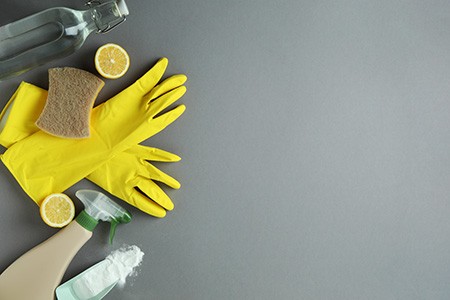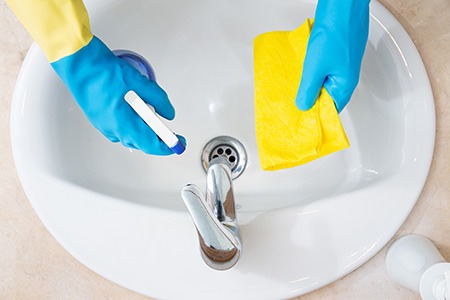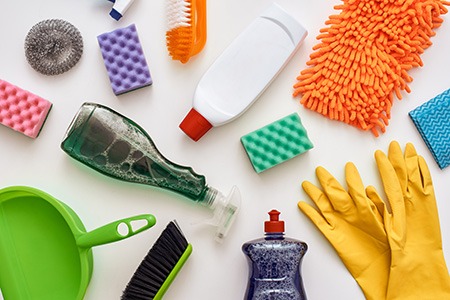Mixing Bleach & Baking Soda Safely & Effectively
Author: Anne Cowart | Editor: Omar Alonso
Review & Research: Jen Worst & Chris Miller

Can you mix bleach and baking soda? Is it safe? Or will your mad science experiment create mustard gas that knocks you out? Mixing bleach and baking soda is safe and effective, and it's a great combination for several cleaning tasks around the home.
Combining the two won't emit harmful gases or produce a toxic solution. It's also great for cleaning walls, killing mold, and whitening laundry. Sodium hypochlorite is the active ingredient in bleach, with strong cleaning power capable of removing the toughest stains.
Like bleach, baking soda is a salt-based product which makes mixing the two a safe practice. Combining the two enhances the cleaning efficacy of each ingredient, boosting the ability to remove tough stains and kill bacteria.
This post gives you everything you need to know about mixing bleach and baking soda. We'll talk about safety and efficacy and look at products you should never mix with bleach.
Is It Safe to Mix Bleach & Baking Soda?

It's safe to mix bleach and baking soda. Let's unpack each component in detail and look at the cleaning applications in the home. There is no dangerous baking soda and bleach reaction, though you want to use it in a well-ventilated area.
Chlorine Bleach
Bleach is the benchmark cleaning standard for keeping white clothing and materials white. Bleach is ideal for removing stains and sanitizing any fabrics. Add a 1/2 cup of chlorine bleach to your laundry detergent, and you supercharge the cleaning power of the wash, restoring your clothing to a bright white. Most white fabrics are okay to bleach, and some colors are too.
Baking Soda
If you have bad odors in the home, baking soda absorbs them. It also has whitening properties similar to bleach but softer on your clothes, and it's safe to use with some colors. Adding baking soda to your laundry removes tough stains and smells. It also doubles as a softener and cleans the washing machine of any built-up grime.
Tips for Mixing Bleach & Baking Soda

While there's nothing toxic or dangerous about mixing bleach and baking soda, there are a few things you need to know before giving it a try. Follow these tips for a safe experience with this powerful cleaning combination.
Mix & Work in a Well-Ventilated Area
Ensure you open all the windows and doors in the room when mixing the combination and where you're applying it. Bleach emits fumes, and they'll damage your health if you inhale them excessively. If you're still smelling bleach after cleaning, then there's fumes present.
Even a short exposure to bleach fumes will irritate your throat, sinus, and lungs, turning your eyes watery and red. Keep the room well-ventilated to remove the fumes and assist with drying the surfaces.
Test the Surface Before Cleaning
Bleach isn't compatible with all surfaces. It's somewhat corrosive and can damage specific materials. Test some of the baking soda/bleach solution on the tiles or plastics you want to clean to ensure you're not going to ruin anything.
Ensure You Mix the Right Ratio
Mix bleach and baking soda in a ratio of one part baking soda to two parts bleach. This balance is usually ideal for cleaning most surfaces. You may also need to adjust it depending on the surface.
Dilute With Water
If there's too much bleach in the solution, you can dilute it with water to weaken the bleach concentration. If the surface testing reveals, it's too strong, dilute it and try again.
Never Mix the Solution With Hot Water
It's safe to dilute bleach with room-temperature water. However, never mix it with hot water, or you'll start a chemical reaction producing toxic chlorine gas. Inhaling or skin exposure to chlorine gas is dangerous, and you can die from it if there's too much gas in an enclosed space.
Wear Gloves to Protect Your Hands
Bleach has a potent anti-bacterial action. Unfortunately, it doesn't discriminate between good and bad bacteria – it kills everything. Getting bleach on your hands will destroy the biomes on your skin, leaving it feeling dry and sore, with a pulsating sensation that feels terrible. Always work with rubber cleaning gloves when you're handling bleach.
Cleaning & Disinfecting Surfaces With Bleach & Baking Soda

Follow this cleaning guide to mix your ideal baking soda and bleach solution. The combination of cleaning agents has several uses around your home.
Step 1: Prep the Surface - Start by wiping the surface you want to clean with a damp rag to remove dirt and debris.
Step 2: Mix the Components - Mix your bleach and baking soda in a 2:1 ratio (two parts bleach, one part baking soda).
Step 3: Apply & Scrub - Apply the solution to your sponge, scrubbing brush, or directly to the surface. Clean away the dirt and grime with a gentle scrubbing action. Remember to test the solution before you start cleaning.
Step 4: Leave it to Work - Leave the solution to work on the surface for five minutes before rinsing it with clean water.
Step 5: Wipe Dry With a Clean Cloth - Wipe the surface dry after rinsing off.
Step 6: Safely Dispose of the Mixture - Follow the procedures for safely disposing of bleach (plenty of dilution while slowly pouring down the drain is fine).
Cleaning Applications for Mixing Bleach & Baking Soda

There are several ways to use this cleaning combination in your home. Before you start, follow these safety tips.
- Work in a well-ventilated area
- Wear rubber gloves to protect your skin
Always put safety first. Nothing is worth more emphasis than your family’s and your own personal safety.
Grout Paste
Mix 1/4c bleach with 3/4c baking soda to create a cleaning paste. This combination is ideal for cleaning grout stains in the bathroom and kitchen. It rips away mold and mildew stains from grout in minutes.
If you're using it as a grout cleaner, make sure there are no other traces of cleaning agents on any surfaces before applying the paste. While you're at it, go ahead and clean your shower head. People want to clean their shower heads without vinegar to avoid the smell. Bleach rinses and dissipates much faster, and the smell doesn't linger as long.
Stain Remover
Diluted bleach and baking soda are ideal for removing everyday household stains. Use it to clean tough dirt around the kitchen and on the window sills, and strip away grease from the cooking hob. Mix 4 teaspoons of bleach with 4 cups of water and 1 teaspoon of baking soda. It's important to note bleach will begin to denature after 24 hours, reducing its cleaning efficacy.
Laundry Whitening Additive
If you got spaghetti sauce on your shirt last night, use a combination of bleach and baking soda to remove it. The baking soda in the blend also assists with deodorizing the washing machine. Use the bleach in the bleach or detergent compartment and put the baking soda inside the drum. It's a potent whitening and cleaning combination when you wash your whites.
Cleaning Walls & Mold
Combining baking soda and bleach removes black mold and mildew from walls. Make a paste with ¼ cup bleach and ¾ cup baking soda in a bucket or plastic container. Don't add water, and ensure you get the paste consistency. Use a brush or sponge and scrub the walls. Let it rest for five minutes, and rinse it away. Dry off the wall with a rag to finish.
Ingredients to Never Mix with Bleach

There are some ingredients you should never mix with chlorine bleach. Acids cause aggressive chemical reactions with the active ingredient in bleach, which is sodium hypochlorite, resulting in dangerous compounds that could end you or severely damage your health. Avoid using the following products in combination with bleach.
Ammonia
Never mix bleach with ammonia. You'll find ammonia in many common household cleaning agents. Most of these products use ammonia as the active cleaning agent, and they have it in significant concentrations that create devastating chemical reactions when added to bleach.
The combination of ammonia and bleach creates a highly toxic chloramine gas. Exposure causes blindness, internal organ damage, and burns in the respiratory tract.
Rubbing Alcohol
Never mix bleach with isopropyl alcohol. It's fine mixing rubbing alcohol with white vinegar and dish soap, but avoid mixing rubbing alcohol with bleach. The combination of isopropyl alcohol and bleach creates chloroform. You'll pass out when mixing it or working with it. Inhaling too much of this chloroform gas can kill you.
Vinegar
Never mix bleach with vinegar. Many homeowners use white spirit vinegar as a cleaning agent around the house. It absorbs smells, removes stains, and brightens surfaces. It's also important to note that dried vinegar on surfaces may activate a chemical reaction when adding a bleach and baking soda solution.
That's why it's important to wipe surfaces with a damp cloth before applying your bleach and baking soda mixture. The combination of this mixture with vinegar creates dangerous chlorine gas.
Lemon Juice & Other Acids
Never mix bleach with anything acidic, and that includes lemon juice. Lemon juice is also a popular everyday organic cleaning agent.
Combining lemon juice with baking soda makes for an effective oven-cleaning agent. However, the acidity of the lemon juice also creates chlorine gas when mixing it with bleach.
Toilet Bowl Cleaners
Never mix bleach with toilet bowl cleaners. These products contain combinations of isopropyl alcohol, ammonia, and other acid bases. That said, bleach is an effective toilet cleaner and much cheaper than most toilet cleaner products. Apply it to the bowl and let it sit for 15 minutes before scrubbing it and flushing.
Drain Cleaners & Other Chemicals
Commercial and household drain cleaners feature acid bases, which are unsuitable for mixing with bleach for the same reasons explained above. You should also avoid mixing bleach with pool chemicals, hydrogen peroxide, and oven cleaners.
Mixing Bleach & Baking Soda Can Be Done Safely
Is it safe to mix bleach and baking soda? Yes, it is, as long as you're diligent about keeping these ingredients away from the other chemicals mentioned above. Mixing bleach and baking soda is a classic home cleaning tactic that works very well with little expense. Just make sure you understand how to stay safe while using it and you'll have a happy, clean home.




